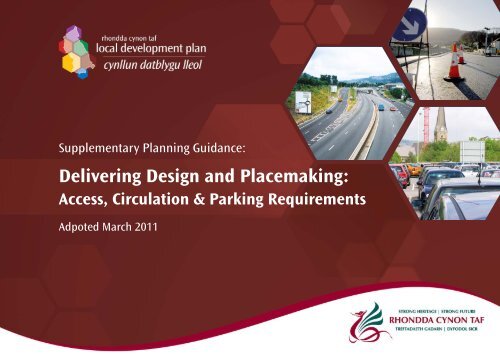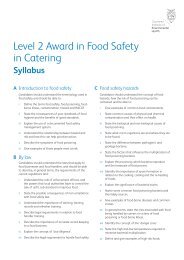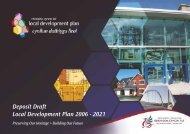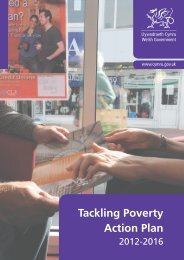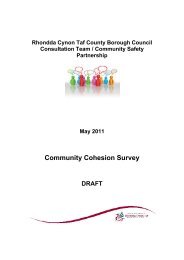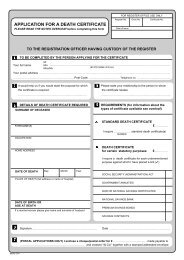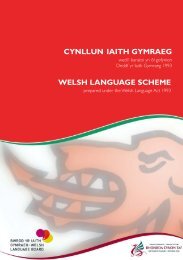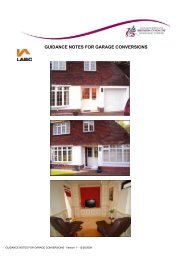Delivering design and Placemaking - Rhondda Cynon Taf
Delivering design and Placemaking - Rhondda Cynon Taf
Delivering design and Placemaking - Rhondda Cynon Taf
- No tags were found...
Create successful ePaper yourself
Turn your PDF publications into a flip-book with our unique Google optimized e-Paper software.
2. Sustainability AppraisalFig.1 Key Social Trends2.5. The Sustainability Appraisal / Strategic Environmental Assessment (SA / SEA)scoping exercise was undertaken between January – April 2006. The process identifiedkey strategic problems, objectives <strong>and</strong> issues for sustainability. The broad issuesidentified were as follows:• Climate change;• Economic development / housing provision;• Transport;Supplementary Planning Guidance:• Protection of the l<strong>and</strong>scape <strong>and</strong> biodiversity;• Town centre vitality; <strong>and</strong><strong>Delivering</strong> • Cultural change. Design <strong>and</strong> <strong>Placemaking</strong>:2.6. A detailed discussion of each of the broad issues identified is contained inAccess, Circulation & Parking Requirementsthe Sustainability Appraisal / Strategic Environmental Assessment Scoping Report(March 2006).Adpoted March 2011Social, Economic <strong>and</strong> Environmental Baseline2.7. In order to ensure that a robust basis was established on which to develop aspatial strategy for the LDP, a review was undertaken of key social, economic<strong>and</strong> environmental data. The review of the available data supports the issuesidentified through the pre deposit consultation process <strong>and</strong> SA / SEA Scopingexercise. The analysis provides a clear picture of the social, economic <strong>and</strong>environmental issues which need to be addressed through the LDP process.The key trends identified are as follows:
<strong>Delivering</strong> Design <strong>and</strong> <strong>Placemaking</strong>:Access, Circulation & Parking RequirementsContents1. Introduction.....................................................................................................45. Appendix ........................................................................................................18• Parking Guidance Notes <strong>and</strong> Guideline Tables.......................................182 Policy Context ..................................................................................................4• Cycle Parking Guidelines..........................................................................32• Motorcycle Parking Guidelines ................................................................353 Issues ..............................................................................................................6• Parking Guidelines for Disabled Person..................................................363.1 Transport Tariff.....................................................................................63.2 Transport Assessment...........................................................................66. Further Reading.............................................................................................373.3 Travel Plans...........................................................................................73.4 Parking..................................................................................................73.5 Design ...................................................................................................73.6 Commuted Sums ..................................................................................84 Planning Considerations & Requirements......................................................84.1 Transport Tariff.....................................................................................84.2 Transport Assessment...........................................................................84.3 Travel Plans.........................................................................................104.4 Parking................................................................................................124.5 Design .................................................................................................144.6 Commuted Sums ................................................................................18Local Development Plan 2006 - 2021 • 3
Supplementary Planning Guidance1. Introduction1.1 This Supplementary Planning Guidance (SPG) has been produced to provideguidance on access, circulation <strong>and</strong> parking in the planning process. A draftwas issued in January 2010 for a six-week consultation period. Responses torepresentations received were approved <strong>and</strong> the SPG as amended by thoseresponses was adopted March 2011.1.2 The guidance contained within this document relates specifically to access,circulation <strong>and</strong> parking requirements. The guidance applies to all categoriesof development for which planning permission is required, including newdevelopments, extensions, redevelopments, conversions <strong>and</strong> material changesof use. The guidance contained within this document will help ensure atransparent approach to the provision of parking, developer contributions,travel plans <strong>and</strong> transport assessments <strong>and</strong>, crucially, will inform applicantsof the Council’s expectations at an early stage of the development process.2. Policy Context2.1 The <strong>Rhondda</strong> <strong>Cynon</strong> <strong>Taf</strong> Local Development Plan (LDP) sets out planningpolicies that will be applied in the County Borough apart from the BreconBeacons National Park. This SPG provides supporting information with regardto the transport policies included in the LDP. It provides details that wouldnot be appropriate in the more strategic LDP <strong>and</strong> is a material planningconsideration in planning decisions.2.2 The SPG principally supports the following LDP policies, although otherpolicies in the LDP also require consideration of transportation implications:1.3 This SPG closely relates to the Planning Obligations SPG: the two should beread in conjunction.4 • Local Development Plan 2006 - 2021
<strong>Delivering</strong> Design <strong>and</strong> <strong>Placemaking</strong>:Access, Circulation & Parking RequirementsPolicy CS 8 – TransportationImprovements to the strategic transportation network in <strong>Rhondda</strong> <strong>Cynon</strong> <strong>Taf</strong>will be secured through a combination of the following:-a) The safeguarding <strong>and</strong> provision of l<strong>and</strong> for the improvement of thestrategic highway network, including development of:-1. The Gelli / Treorchy Relief Road;2. The Ynysmaerdy to Talbot Green Relief Road;3. The A4059 Aberdare Bypass Extension, <strong>and</strong>4. A465 Abergavenny / Hirwaun Dualling.b) The Implementation of a strategic transport corridor management systemin the following strategic corridor areas;1. A4119 / A473 Corridor;2. A470 / A4059 Corridor, <strong>and</strong>3. A4059 / A465 Corridor.Provision of additional improvements in the highway network, public transportimprovements <strong>and</strong> walking <strong>and</strong> cycling provision will be sought in accordancewith policies NSA 20 to NSA 23 <strong>and</strong> SSA 18 to SSA 21.Policy AW 5 - New DevelopmentDevelopment proposals will be supported where:-1. Amenitya). The scale, form <strong>and</strong> <strong>design</strong> of the development would have nounacceptable effect on the character <strong>and</strong> appearance of the site <strong>and</strong> thesurrounding area;b). Existing site features of built <strong>and</strong> natural environmental value would beretained;c). There would be no significant impact upon the amenities of neighbouringoccupiers;d). The development would be compatible with other uses in the locality;e). The development would include the use of multi-functional buildings;f). The development <strong>design</strong>s out the opportunity for crime <strong>and</strong> anti socialbehaviour.2. Accessibilitya). The development would be accessible to the local <strong>and</strong> wider communityby a range of sustainable modes of transport;b). The site layout <strong>and</strong> mix of uses maximises opportunities to reducedependence on cars;c). The development would have safe access to the highway network <strong>and</strong>would not cause traffic congestion or exacerbate existing trafficcongestion;d). Car parking would be provided in accordance with the Council’sSupplementary Planning Guidance on <strong>Delivering</strong> Design <strong>and</strong><strong>Placemaking</strong>: Access, Circulation <strong>and</strong> Parking Requirements.Local Development Plan 2006 - 2021 • 5
Supplementary Planning Guidance3. Issues3.1 Transport Tariff3.1.1 The traffic growth in the County Borough now results in a number ofsignificant congestion bottlenecks on the network including key strategicjunctions. The level of congestion now experienced means thatadditional traffic cannot be accommodated on the existing road networkwithout significant infrastructure improvements. An alternative to theindividually negotiated Section 106 process, the Planning ObligationsSPG introduces a “Transport Tariff”. The introduction of a transporttariff on development sites means the following:• The cumulative effect of additional traffic can be dealt with in afairer manner;• A more comprehensive solution is possible, avoiding piecemealsmall scale improvements;• The cost implications of developing a site can be identified at anearlier stage, which can be offset against l<strong>and</strong> values.3.1.2 A separate technical report has been produced by the Council entitled“Strategic Transport Corridors Infrastructure Needs Studies – Report 4:Charging Methodology Report”. This report is one of four that considersthe development implications, particularly of the larger strategic sites,on the main movement corridors in the County Borough. It details thebackground behind the consideration of introducing a transport tarifffor new development, the calculations used to derive the level oftransport tariff <strong>and</strong> how the tariff could be applied.3.1.3 The transport tariff relates to infrastructure improvements on the strategicnetwork that are required to accommodate the anticipated growth intraffic from the strategic sites <strong>and</strong> other development sites identified inthe LDP process. It does not cover public transport investment in eitherinfrastructure or new/enhanced service levels. Nor does it cover highwayimprovements required to gain access to the site or to accommodateadditional traffic in the vicinity of the site. Any contributions required forthese purposes would be calculated on a site by site basis informed bythe Transport Assessment (please see 3.2 below).3.1.4 Importantly the transport tariff is also not geared to solving existingtransport problems or issues relating to natural growth.3.2 Transport Assessment3.2.1 A Transport Assessment (TA) <strong>and</strong> Transport Implementation Strategy(TIS) should be prepared <strong>and</strong> submitted alongside the relevantplanning application for any development that could have significanttransport implications. A TA is a comprehensive <strong>and</strong> consistent reviewof all the potential transport impacts of a proposed development orredevelopment, with an agreed plan to reduce any adverseconsequences. Covering access by all modes of travel, a TA shouldprovide information to enable the Council to consider how theproposed development is likely to function in transport terms <strong>and</strong> whateffect, beneficial, adverse or otherwise the development will have onthe surrounding highway network. A TIS would be required to identifyhow necessary infrastructure <strong>and</strong> services would be provided.6 • Local Development Plan 2006 - 2021
<strong>Delivering</strong> Design <strong>and</strong> <strong>Placemaking</strong>:Access, Circulation & Parking Requirements3.2.2 This document provides guidance on Transport Assessment <strong>and</strong> reflectsTAN 18: Transport <strong>and</strong> the Department for Transport’s (2007) ‘Guidanceon Transport Assessment’ publication.3.3 Travel Plans3.3.1 Travel Plans have a significant role to play in achieving a reduction inroad traffic by enabling organisations to manage their travel needs <strong>and</strong>encourage more sustainable modes of travel. A travel plan is a packageof measures <strong>design</strong>ed to reduce car use (especially single occupancyvehicles) from new developments by supporting alternative modes oftransport <strong>and</strong> reducing the need to travel in the first place. Guidanceon Travel Plans is given below.3.4 Parking3.4.1 This document introduces revised guidelines for parking. These arebased on the document ‘Wales Parking St<strong>and</strong>ards - 2008’ produced bythe County Surveyors Society, but have been developed to beappropriate for <strong>Rhondda</strong> <strong>Cynon</strong> <strong>Taf</strong>. The Parking Guidelines are amaterial consideration in individual planning applications.3.4.2 Paragraph 8.4.2 of Planning Policy Wales Edition 4 (2011) states that ‘CarParking Provision is a major influence on the choice of means of transport<strong>and</strong> the pattern of development. Local authorities should ensure that newdevelopments provide lower levels of parking than have generally beenachieved in the past. Minimum parking st<strong>and</strong>ards are no longer appropriate.Local authorities should develop an integrated strategy on parking to supportthe overall transport <strong>and</strong> locational policies of the development plan.’3.4.3 Technical Advice Note 18: Transport (2007) supplements PlanningPolicy Wales <strong>and</strong> states that ‘Maximum car parking st<strong>and</strong>ards should beused at regional <strong>and</strong> local level as a form of dem<strong>and</strong> management’ <strong>and</strong>,that for new development, regard should be given to alternativetransport modes, economic objectives, public <strong>and</strong> shared parkingarrangements.3.4.4 Therefore, this document introduces “maximum” parking st<strong>and</strong>ards. Asystem of zones is also introduced for parking st<strong>and</strong>ards, based on theWales Parking St<strong>and</strong>ards.3.4.5 This new approach to transport, with the change from predicting <strong>and</strong>providing for cars to managing traffic <strong>and</strong> reducing car dependency, meansa new role for parking provision <strong>and</strong> control. However, whilst maximumst<strong>and</strong>ards have been introduced, the document still aims to ensure thatdevelopment is accompanied by sufficient parking space for private cars<strong>and</strong> service vehicles to avoid the need for vehicles to park on street <strong>and</strong>thereby cause congestion, danger <strong>and</strong> visual intrusion.3.5 Design (please also see the Design <strong>and</strong> <strong>Placemaking</strong> SPG)3.5.1 This section gives some guidance on specific points, but Manual forStreets (MfS), published in 2007 by the Department of Communities<strong>and</strong> Local Government, the Department for Transport <strong>and</strong> the WelshAssembly Government, <strong>and</strong> Manual for Streets 2 (MfS2), published in2010 by the Chartered Institution of Highways <strong>and</strong> Transportation, givemore in depth guidance on <strong>design</strong>.3.5.2 In the past, the car dominated layout <strong>design</strong>s. Today much greateremphasis is placed on walking, cycling <strong>and</strong> the use of public transport<strong>and</strong> this needs to be reflected in new <strong>design</strong>s. However, it must beappreciated that car ownership is likely to remain high, premises needto be serviced, refuse needs to collected <strong>and</strong> access must be providedfor emergency vehicles.Local Development Plan 2006 - 2021 • 7
Supplementary Planning Guidance3.5.3 MfS demonstrates the benefits that can result from good <strong>design</strong> <strong>and</strong>assigning a higher priority to pedestrians <strong>and</strong> cyclists. It sets out anapproach to streets that recognises their role in creating spaces thatbenefits those that live or work there.3.5.4 This section also contains information regarding considered statutoryPublic Rights of Way in development.3.6 Commuted Sums3.6.1 These would be required for extraordinary highway maintenance costsassociated with infrastructure provision such as structures, trafficsignals, soakaways, traffic calming, street furniture <strong>and</strong> use ofinnovative materials.4. Planning Considerations& Requirements4.1 Transport Tariff4.1.1 A transport tariff would apply to all developments that would require a TA(see 4.2 below). This is with the exception of residential applications wherethe transport tariff would be applicable to 5 or more dwellings, not 50 asapplied to a TA requirement.4.1.2. Further details with regard to the development of the transport tariffare contained in the Strategic Transport Corridor Infrastructure NeedsStudy Report No. 4: Charging Methodology Report <strong>and</strong> itsimplementation in the Planning Obligations SPG.4.2 Transport Assessment4.2.1 The following guidance defines the criteria governing when a TA isrequired by the Council, the areas it should cover <strong>and</strong> the issues thatshould be considered in any assessment that may subsequently becarried out. This guidance determines whether an assessment isrequired <strong>and</strong>, if so, what the level <strong>and</strong> scope of that assessment shouldbe.4.2.2 The coverage <strong>and</strong> detail of the TA should reflect the scale of development<strong>and</strong> the extent of the transport implications of the proposal. Developersshould hold early discussions with the Council in order to clarify whethera Transport Assessment is necessary <strong>and</strong>, if so, to ‘scope’ its requirements.The initial scoping of the contents <strong>and</strong> coverage of the TA is particularlyimportant. It should cover the likely junctions <strong>and</strong> links to be considered,the timings (days of the week, time of day) of any surveys, likely eventsthat could influence current travel patterns <strong>and</strong> identification of anyexisting data that would be beneficial to the work. Time spent on scopinga TA is likely to result in a submission that has addressed the relevantissues <strong>and</strong> avoids abortive work.4.2.3 A Transport Assessment should include the following key features:• Description of l<strong>and</strong>-use proposals;• Movements expected to be generated by the site;• Identification of times of peak dem<strong>and</strong> <strong>and</strong> corresponding networkpeak hours;• Forecast traffic flows 10-15 years beyond the projected opening year(15 years if the development impacts on a Trunk Road or KeyCorridor);8 • Local Development Plan 2006 - 2021
<strong>Delivering</strong> Design <strong>and</strong> <strong>Placemaking</strong>:Access, Circulation & Parking Requirements• Any special transport characteristics of the development;• An assessment of committed developments in the area;• Relationship to LDP policies <strong>and</strong> proposals affecting the site;• Expected modal share of walking, cycling, public transport <strong>and</strong> carincluding justification;• Identification of infrastructure improvements required for walking,cycling <strong>and</strong> public transport;• An analysis of the injury accident records on the public highway inthe vicinity of the site access for the most recent three-year period,or five-year period if the proposed site has been identified as withina high accident area;• Justification of any highways improvements, including access<strong>design</strong>;• Parking numbers, controls <strong>and</strong> management, including cycles <strong>and</strong>motorcycles;4.2.4 Table 1 sets out suggested thresholds above which a TA will be requiredby the Local Authority. For the avoidance of doubt, these thresholdsapply to new development, extensions, redevelopments, conversions,<strong>and</strong> material changes of use.Table 1: Thresholds above which a TA will be requiredL<strong>and</strong> UseThresholdFood retail>1,000m 2 gross floor areaNon-food retail>1,000m 2 gross floor areaCinemas <strong>and</strong> conference facilities >1,000m 2 gross floor areaCommunity / leisure facilities >1,000m 2 gross floor areaBusiness>2,500m 2 gross floor areaIndustry>5,000m 2 gross floor area• Proposals to assist the mobility impaired;• Mechanisms for enforcing modal targets;• Servicing facilities (where appropriate);• Possible appropriate planning conditions <strong>and</strong>• Transport Implementation Strategy (more details of which arecontained TAN 18: Transport).Distribution <strong>and</strong> warehousingHospitalsHigher <strong>and</strong> further educationSchoolsStadiaHousingHotels>10,000m 2 gross floor area>2,500m 2 gross floor area>2,500m 2 gross floor areaAll new schools>1,500 seats>100 dwellings>1,000m 2 gross floor areaLocal Development Plan 2006 - 2021 • 9
Supplementary Planning Guidance4.2.5 Developments that fall under the thresholds in Table 1 but are likelyto require 10 or more parking spaces or generate stopping traffic onthe highway are likely to require a Transport Statement (TS). The TSshould set out the existing transport situation, a description of theproposed development, any transport <strong>and</strong> parking issues <strong>and</strong> how theywill be dealt with.4.2.6 As advised in TAN 18, there may be instances where the transportnetwork is particularly sensitive <strong>and</strong> consequently the thresholds forthe requirement for a TA will be lower. Developers are advised tocontact the Council to discuss the potential requirement for TA ondevelopments below the thresholds in Table 1. A threshold might berelaxed where the planning application is for a specific occupier whoprovides evidence that unusually low trip generation is likely.4.2.7 All new schools, hospitals <strong>and</strong> other healthcare facilities should besubject to a TA. The level of detail should be proportionate to the scaleof the development, although the TA should clearly set out how theproposed location meets the principles of sustainability.4.2.8 Where a number of small / medium piecemeal developments areproposed in close proximity to one another it may be appropriate toundertake one overarching assessment <strong>and</strong> this could be done as partof a comprehensive study.4.2.9 As part of the development of the Transport Assessment Strategy, theCouncil will enter into negotiations / planning obligations withdevelopers in order to secure satisfactory accessibility to newdevelopment by all modes of travel. The level <strong>and</strong> form of provisionwill be determined in relation to the nature <strong>and</strong> scale of development<strong>and</strong> specific local circumstances.4.2.10 With regard to additional improvements required to the strategicnetwork (as defined in Section CS 8 (b) of the LDP), these are addressedunder the transport tariff. More detailed guidance on this is given inthe Planning Obligations SPG.4.2.11 In certain circumstances the Council will require a review of TAassumptions (e.g. trip generation <strong>and</strong> traffic distribution) to beundertaken 1 year after substantial occupation with a financial bondin place, should subsequent transport related improvements benecessary. This review will be based on forecast traffic generation versusobserved traffic generation. Should the latter be materially higher, thenat the discretion of the Highway Authority, the financial bond could beused for improvements.4.3 Travel Plans4.3.1 The following guidance outlines the types of development for which aTravel Plan is appropriate, the size of that development, thetransportation measures considered appropriate, criteria covering thecircumstances in which the various measures should be considered <strong>and</strong>modal split targets. Consideration is also given to implementation,enforcement <strong>and</strong> monitoring issues. Travel Plans would form part of aSection 106 agreement related to the development proposed.4.3.2 Development proposals that will have a significant transportimplication will be required to be accompanied by a Travel Plan beforeany granting of planning permission. The implementation of TravelPlans will be secured through a condition or planning obligation onthe planning permission. Key elements of a travel plan should include:• The setting of short <strong>and</strong> medium term targets for different modes;10 • Local Development Plan 2006 - 2021
<strong>Delivering</strong> Design <strong>and</strong> <strong>Placemaking</strong>:Access, Circulation & Parking Requirements• The identification of enforcement measures, if targets are not met;• The appointment of a Travel Plan Co-ordinator;• Establishing a car sharing register <strong>and</strong> priority parking spaces forcar sharers;• Public transport, walking <strong>and</strong> cycling enhancements <strong>and</strong> incentives,in order to promote <strong>and</strong> encourage sustainable accessibility;• All targets for parking reductions should be clearly quantified <strong>and</strong>related to specific time periods; <strong>and</strong>• The monitoring of plans at least on an annual basis <strong>and</strong> reviewedevery three years.4.3.3 As a guide, travel plans will be required by the Council fordevelopments that correspond with the TA thresholds contained inTable 1.4.3.4 The Council will require a Travel Plan to be prepared for all hospitals<strong>and</strong> educational establishments due to them being significant tripgenerators. New <strong>and</strong> exp<strong>and</strong>ed school facilities should be accompaniedby a School Travel Plan which promotes safe cycle <strong>and</strong> walking routes,restricts parking <strong>and</strong> car access at <strong>and</strong> around schools, <strong>and</strong> includeson-site changing <strong>and</strong> cycle storage facilities.4.3.5 Travel Plans will also be required for developments that are likely tohave significant transport implications, which include:• Smaller developments that would generate significant amounts oftravel in, or near to, air quality management areas <strong>and</strong> in otherlocations where there are local initiatives or targets for thereduction of road traffic, or the promotion of public transport,walking <strong>and</strong> cycling.• Developments where a Travel Plan would help address a particularlocal traffic problem (key corridor or junctions), which mightotherwise have to be refused on local traffic grounds, for example,where overspill parking might occur from developments with lowor nil off-street parking provision.4.3.6 It is recognised that there may be situations where it may be justifiableto apply the thresholds in a flexible way, taking the merits <strong>and</strong>circumstances of each planning application into consideration.Developers should hold early pre-application discussions with theCouncil in order to clarify whether a Travel Plan is necessary <strong>and</strong>, if so,to ‘scope’ its requirements.4.3.7 A Travel Plan should include the provision of up-to-date informationabout public transport services, timetables, <strong>and</strong> opportunities for carsharing (e.g. via a car share website). However, additional measuresmay also be sought, including provision of <strong>design</strong>ated car share parkingspaces, discount vouchers/ passes for public transport, or financialcontributions towards shuttle buses <strong>and</strong> park <strong>and</strong> ride schemes. Theoperation <strong>and</strong> monitoring of the use of car parks is likely to be animportant element of any action plan in a Travel Plan.4.3.8 In establishing targets, accurate baseline information on car access to<strong>and</strong> from the site is imperative. Travel Plans should start by relatingtargets to the information provided by transport databases such asTRICS (Trip Rate Information Computer System). TRICS is a multi modaltravel database that is primarily used to predict trips generated bydevelopment based upon surveys of real sites. This information shouldalso form part of the site’s TA.Local Development Plan 2006 - 2021 • 11
Supplementary Planning Guidance4.3.9 Once planning permission has been granted, the Travel Plan will providethe ongoing management tool for implementing the necessary transportmeasures to the site over the long term <strong>and</strong> will require a nominated travelplan coordinator, unless in special circumstances agreed with the Council itis not necessary. It would be beneficial to liaise at an early stage with theSouth East Wales Transport Alliance (Sewta) travel plan coordinator.4.3.10 Monitoring progress in achieving targets to ensure compliance withplanning obligations is one of the main purposes of monitoring TravelPlans. More generally, monitoring should provide regular informationabout how the plan is working in practice <strong>and</strong> whether it needs to beadjusted. Where monitoring reveals problems, there should be anopportunity to review the plan <strong>and</strong> to take remedial action. Ultimately,if monitoring shows that a travel plan is failing <strong>and</strong> no action is takento address this, enforcement proceedings may be needed.4.3.11 In certain circumstances the Council may require the installation ofpermanent classified Automatic Traffic Counters (ATCs) at accesses /egresses to new development to monitor vehicle trips associated witheach development site over time. Counters will usually be requiredonly for larger developments, or other developments with potentialfor a wide variation between estimated <strong>and</strong> actual traffic flows.4.3.12 Relying solely on the provision of infrastructure to meet the dem<strong>and</strong>sresulting from additional development throughout the County Boroughwould involve significant investment, particularly in terms of roadnetwork improvements. Travel Plans can help reduce this dem<strong>and</strong> butthey must be robust, implemented <strong>and</strong> enforced.4.3.13 The Council can use financial penalties as the basis for encouragingsustainable travel through Travel Plans. Developers or end users canbe tied into financial penalties linked to yearly modal shift targetswhere the implementation of a Travel Plan is a requirement of thegranting of planning permission.4.3.14 The implementation of, continued adherence to <strong>and</strong> development of,the travel plan is key in encouraging modal shift <strong>and</strong> reducing singleoccupancy journeys. The Council will introduce a financial penalty(which would be specified in the Section 106 Agreement) where themodal split targets of the Travel Plan are not achieved. Further detailsare given in the Planning Obligations SPG.4.4 Parking4.4.1 The following section outlines guidelines for the provision of parkingin developments. Appendix 1 gives the specific requirements in respectof parking.4.4.2 These guidelines cover all built up <strong>and</strong> rural areas. The level of parkingto be provided may depart from the guidelines by providing lessparking, where it can be demonstrated that there would be nounacceptable impacts on highway safety, free flow of traffic or amenity.4.4.3 The following Parking Zones are considered appropriate for <strong>Rhondda</strong><strong>Cynon</strong> <strong>Taf</strong>. Where a development lies adjacent or close to the zoneboundary, the level of provision of parking will primarily be accordingto the zone within which the site lies, but levels of accessibility will betaken into account <strong>and</strong> should be discussed with the Council prior tothe submission of a planning application. The Zones are based on theWales Parking St<strong>and</strong>ards, but have been renumbered as two of thezones within the above document have not been used, as they are notstrictly applicable to <strong>Rhondda</strong> <strong>Cynon</strong> <strong>Taf</strong>.12 • Local Development Plan 2006 - 2021
<strong>Delivering</strong> Design <strong>and</strong> <strong>Placemaking</strong>:Access, Circulation & Parking RequirementsZone 1 – Town CentresThis relates to the principal town centres of Pontypridd <strong>and</strong> Aberdare,which are destinations for most activities not met within localcommunities. The town centres have a full range of retail activity <strong>and</strong>many commercial businesses, all within walking distance. The townsare the focus of the local bus network <strong>and</strong> main stations on the railnetwork. The built up density is high with little private car parking.There are significant parking restrictions <strong>and</strong> sufficient public off-streetcar parking provision.Zone 2 – UrbanThe zone includes the centres of Key Settlements (as defined in the LDP)which contain the range of basic local facilities generally within 400mwalking distance, as well as Llantrisant /Talbot Green. The settlementshave regular <strong>and</strong> frequent bus services to a range of destinations offeringpractical access to most but not all essential facilities. The curtilage ofsites in these centres restricts, to an extent, what car parking can beprovided. There are likely to be some restrictions on on-street parking<strong>and</strong> may be some available off-street parking.The Key Settlements are:• Tonyp<strong>and</strong>y • Tonyrefail • Treorchy• Mountain Ash • Porth • Ferndale• Llanharan • HirwaunZone 3 – Suburban or Near UrbanZone 3 comprises all of the remaining urban areas outside of thePrincipal Towns <strong>and</strong> the Key Settlements, as contained within thesettlement boundaries of the LDP. These areas contain the smallersettlements <strong>and</strong> local centres offering a range of local facilities. Thereis generally a regular bus service to the town centres <strong>and</strong> in some cases,there are local railway stations. The Strategic Sites of the LDP are alsoincluded in this zone for the purposes of the parking guidelines.Zone 4 – CountrysideThe zone comprises the remainder of the County Borough, which isthe small villages with limited local facilities <strong>and</strong> countryside, <strong>and</strong> isdefined by those areas falling outside of the settlement boundary or aStrategic Site.4.4.4 In assessing the parking requirements for a particular development,the Council will take into account a number of factors in relation tothe development where relevant <strong>and</strong> its location. These are listedbelow. However it should be noted that some of these factors areoutside direct planning control:(a) accessibility to <strong>and</strong> the service provided by the public transportsystem;(b) the availability of private buses or the extent of car pooling;(c) the relative proportions of full time / part time / local catchmentof labour;(d) shift patterns;Local Development Plan 2006 - 2021 • 13
Supplementary Planning Guidance(e) accessibility by walking <strong>and</strong> cycling;(f) the existing <strong>and</strong> possible future congestion in streets adjacent tothe development;(g) accessibility to <strong>and</strong> the availability of public <strong>and</strong>/or private carparking space in the vicinity;(h) Topography of the area.4.4.5 Section 106 Agreements may be negotiated with developers <strong>and</strong> thesecan include a number of measures to mitigate the potential impact ofdevelopment <strong>and</strong> to address concerns.4.4.6 All parking areas other than residential parking areas off low-trafficked,low speed, minor residential roads should be <strong>design</strong>ed to allow vehiclesto enter <strong>and</strong> leave the site in forward gear. Safe pedestrian access routes<strong>and</strong> circulation must be provided within all new parking areas.4.4.7 Where Travel Plans are required as a condition of planning consent<strong>and</strong> supported by a bond, appropriate relaxation of the parkingrequirements may be made following acceptance of the details of asubmitted travel plan, provided that measures to enforce compliancewith the Travel Plan are included within a Section 106 Agreement.4.4.8 In certain circumstances, e.g. Conservation Areas, relaxations of thest<strong>and</strong>ards may be allowed in order to preserve environmental conditions.4.4.9 The absence of parking st<strong>and</strong>ards for a particular l<strong>and</strong> use does notmean that no parking provision will be required, for example nospecific guidelines are included for veterinary surgeries, funeral homes<strong>and</strong> churches. The provision of parking in such developments will beconsidered on an individual basis.4.4.10 The Council reserves the right to treat all planning applications on theirmerits according to the size, nature, location, density, employment <strong>and</strong>traffic generation characteristics of the proposed development <strong>and</strong> itsimpact on the local <strong>and</strong> regional highway network.4.4.11 The tables in Appendix 1 set out the parking guidelines by l<strong>and</strong> use<strong>and</strong> where appropriate, according to Parking Zone. The l<strong>and</strong> uses arein summary:a) Residential Developmentsb) Office Developmentsc) Shopsd) Retail Warehousing <strong>and</strong> Commercial Garagese) General Industry, Distribution <strong>and</strong> Storagef) Places of Entertainment / Community Establishmentsg) Hotels <strong>and</strong> Restaurantsh) Educational Establishments.4.5 Design4.5.1 It is a requirement that most types of application for planningpermission are accompanied by a ‘Design <strong>and</strong> Access Statement’.Guidance on the content of Design <strong>and</strong> Access Statements is containedwithin Technical Advice Note (TAN) 12: Design (2009) <strong>and</strong> the Design<strong>and</strong> <strong>Placemaking</strong> SPG.14 • Local Development Plan 2006 - 2021
<strong>Delivering</strong> Design <strong>and</strong> <strong>Placemaking</strong>:Access, Circulation & Parking Requirements4.5.2 MfS is a material consideration in determining planning applications<strong>and</strong> applicants should have regard to it in forming their proposals.Applicants will be expected to demonstrate in their Design <strong>and</strong> AccessStatement how they have used MfS.4.5.3 MfS should be used when considering scheme layout as detailed above.Developers should also follow the points detailed below in thefollowing paragraphs.4.5.4 The maximum number of dwellings that should be served from a singleaccess point is 300. Over 300 dwellings, a second dedicated emergencyaccess should be identified to cater for the emergency services.Extensive development off a single point of access can conflict with theneeds of emergency services as the access will be vulnerable to beingblocked. In order to minimise this risk new development which resultsin more than 150 dwellings being served by a single access is unlikelyto be acceptable.4.5.5 For developments in excess of 300 dwellings, two main access pointswould be required to cater for the adequacy of the roads serving thedevelopment <strong>and</strong> accessibility by emergency services <strong>and</strong> publictransport.4.5.6 Where new development is proposed, access will be required to theexisting highway network. The Highway Authority will wish to ensurethat such accesses are not detrimental to highway safety. Emergencyvehicles should be able to access all dwellings <strong>and</strong> travel distanceswithin estates should be minimised.4.5.7 Street dimensions are fundamental to achieving a successful balancebetween the needs of vehicles <strong>and</strong> all other street users. Designers ofnew streets, roads <strong>and</strong> changes to existing highways will need todemonstrate that they have taken into account all of the followingfactors:• The primary <strong>and</strong> secondary function of the street, road <strong>and</strong>/ orcarriageway• The volume of vehicular traffic <strong>and</strong> pedestrian activity• Parking strategy for the development• Traffic composition – vehicle type, frequency of larger vehiclemovements• Design speed for the street, road <strong>and</strong>/or carriageway, to be 20mphor less in residential areas• The demarcation between carriageway <strong>and</strong> footway (e.g. kerb, streetfurniture, trees, planting)• The curvature of the street (bends require greater width toaccommodate the swept path of larger vehicles)• Any intention to include one-way streets, or short sections of singlelane working in two way streets• The safety of all highway users.4.5.8 In parts of residential developments where there is a low probabilityof two opposing movements by two larger vehicles, it may beappropriate to have carriageway widths lower than the st<strong>and</strong>ard 5.5metres.4.5.9 Where there is a higher probability <strong>and</strong> higher frequency of opposinglarger vehicle movements such as on a busy public transport route<strong>design</strong>ers should consider the need for higher carriageway widths.Local Development Plan 2006 - 2021 • 15
Supplementary Planning Guidance4.5.10 Whilst the concept of reduced carriageway widths meets many of theobjectives in the new thinking on residential layouts – they will onlywork if detailed consideration is given to parking. There are strongpossibilities that parking will occur wherever it is remotely possible, orvehicles will use part of the footway. The highway <strong>design</strong> must wherenecessary <strong>design</strong> out inappropriate parking opportunities, plus ensurethere is appropriate space for parking. Car ownership will remain highso residential layouts must accommodate the parked vehicle whileoffering alternatives to its use.4.5.11 Regard should also be had to the details contained within <strong>Rhondda</strong><strong>Cynon</strong> <strong>Taf</strong>’s “Residential, Industrial <strong>and</strong> Commercial Estate RoadsDesign Guide”. These include engineering st<strong>and</strong>ards for highway<strong>design</strong>. However, it is important that <strong>design</strong>ers primarily <strong>design</strong> places<strong>and</strong> consider the highway arrangements that are appropriate for theplace being created in each circumstance. They should not make newsites look heavily engineered. More advice is given in this respect in theDesign <strong>and</strong> <strong>Placemaking</strong> SPG.4.5.4 Public Rights of Way4.5.13 The effect of development on a public right of way, as defined by theCountryside Act 1981, is a material consideration in the determinationof planning applications.4.5.14 Where possible, existing paths that are convenient link routes, haveclear recreational value or provide access to the countryside should beretained on their current line. However, it is sometimes possible todivert a path onto an equally convenient <strong>and</strong> attractive route, or ontoa better or more convenient route.4.5.15 Where there are new housing or other developments it may benecessary to create a new path to conveniently link with places of work,services, leisure <strong>and</strong> countryside. Such paths should be dedicated asnew public rights of way <strong>and</strong> added to the Definitive Map.4.5.16 There is potential for conflict between the path users <strong>and</strong> those wholive near the paths concerned. There is often a fear, real or perceived,of nuisance to those who live or work near to paths. The followingprinciples should be incorporated in the <strong>design</strong> of new paths or whereexisting paths are incorporated in a development:• Consider public rights of way at the early <strong>design</strong> stage;• Ensure paths are direct, well lit, open <strong>and</strong> clear of hiding places;• Set paths in l<strong>and</strong>scape strip to avoid nuisance to neighbouringproperties;• If possible keep paths away from sides <strong>and</strong> rear of properties;• Avoid planting hedges that may obscure the line of a path or makeaccess physically difficult;• Keep the widths of new paths sufficiently wide to make them seeminviting <strong>and</strong> easy for everyone to use.4.5.17 Developers should bear in mind the needs of the less able <strong>and</strong>disabled. Steep gradients steps <strong>and</strong> stiles can cause difficulties for wheelchair users, the elderly <strong>and</strong> for these with pushchairs. Paths should beproperly drained <strong>and</strong> although it is appreciated that would not beenvironmentally acceptable for most rural paths to be surfaced, incertain circumstances paths should be surfaced (contact CountrysideSection, Disability Wales or Fieldfare Trust for further advice).16 • Local Development Plan 2006 - 2021
<strong>Delivering</strong> Design <strong>and</strong> <strong>Placemaking</strong>:Access, Circulation & Parking Requirements4.5.18 Detailed st<strong>and</strong>ards <strong>and</strong> guidelines are also provided in the ‘BTCountryside for All’ h<strong>and</strong>book.4.5.19 There is no general rule applying to the width of public rights of way<strong>and</strong> the width is a matter of fact to be determined in each case.Sometimes the width is formally recorded on the Definitive Statement,or it may be the width between fence or hedge boundaries, or thewidth may also be that which the public have customarily enjoyed.4.5.20 In the absence of specific evidence a reasonable useable width isusually considered to be 2 metres for a footpath, 3 metres for abridleway <strong>and</strong> 5 metres for a byway.4.6 Commuted Sums4.6.1 New developments that result in extraordinary maintenance costsassociated with structures, soakaways, traffic signals, street furniture,ground maintenance <strong>and</strong> use of innovative materials would have tobe supported by commuted sums from developers.4.6.2 The financial contributions will be used for regular inspection <strong>and</strong>treatment of defects as well as replacement of materials <strong>and</strong> streetfurniture.4.5.21 In the case of an enclosed footpaths <strong>and</strong> bridleways greater widthsshould generally be provided, this should usually be 3 metres forfootpaths <strong>and</strong> 4 metres for bridleways.4.5.22 Cyclists are legally entitled to use bridleways but not footpaths. Whereit is intended for a route to be upgraded for cyclists, for example byresurfacing a bridleway, care should be taken to ensure that the surfaceis suitable for horse-riders <strong>and</strong> other users. When any change of use isproposed, a Risk Assessment should be carried out.4.5.23 New development, especially housing, can create a significant increasein use of local paths. This can cause problems if the public right ofway is, for example, unsurfaced <strong>and</strong> has not historically seen heavyuse. In these cases, the Council may assess the impact of thedevelopment on local paths <strong>and</strong> may seek financial contributions fromdevelopers to upgrade them so as to accommodate this additional use.Local Development Plan 2006 - 2021 • 17
Supplementary Planning Guidance5. AppendixParking Guidance Notes <strong>and</strong> Guidelines TablesThe following notes apply to the parking guidelines:Operational Parking Space - Sufficient space to allow the maximum number <strong>and</strong>size of vehicles likely to serve the development at any one time <strong>and</strong> to manoeuvrewith ease <strong>and</strong> st<strong>and</strong> for loading <strong>and</strong> unloading without inconvenience to vehicles<strong>and</strong> pedestrians on the public highway or to other users of the site. Space for staffcars which, by the nature of the business, is required for day to day operation, mayalso be included.Non-Operational Parking Space - The space occupied by vehicles not necessarilyused for the operation of the premises.Residential Parking Space - Includes space required for residents <strong>and</strong> space for carsof people visiting the residents.Gross Floor Area - The st<strong>and</strong>ards that are related to floor areas are gross floor area,i.e. including external walls, except where the text stipulates otherwise in respect ofpublic houses, restaurants, cafes <strong>and</strong> places of worship.Extension or Development of Existing Buildings – For industrial, office, commercialpremises <strong>and</strong> pre-1914 public houses, under 235m² gross floor area, an increase of20% will be permitted without the need for additional parking. This allowance canonly be made once <strong>and</strong> any parking displaced must be relocated.Public Transport Accessibility – Public transport provision has the potential to reducethe use of the car <strong>and</strong> where appropriate the level of this provision should beenhanced as planning gain through the planning process at the expense of developers.Ease of access to public transport is related to required parking levels through thezoning system introduced by this SPG.Employment Density - The st<strong>and</strong>ards have been assessed on density norms (retail19.5m 2 per employee; industrial 35 - 45m² per employee, office 16.5m 2 peremployee). Variations in density may be treated on their merits.L<strong>and</strong> Use - for the purpose of applying the parking st<strong>and</strong>ards the use classes in theTown <strong>and</strong> Country Planning (Use Classes) Order 1987 <strong>and</strong> its subsequentamendments. Are used as shown in Table 2.18 • Local Development Plan 2006 - 2021
<strong>Delivering</strong> Design <strong>and</strong> <strong>Placemaking</strong>:Access, Circulation & Parking RequirementsTable 2: Use ClassesUse ClassesClass A1: ShopsClass A2: Financial & Professional ServicesClass A3: Food & DrinkClass B1: BusinessClass B2: General IndustrialClass B8: Distribution, including open air storageClass C1: HotelsClass C2: Residential InstitutionsClass C3: Dwelling housesClass D1: Non-Residential InstitutionsClass D2: Assembly <strong>and</strong> LeisureL<strong>and</strong> Uses in Parking GuidelinesShops, post offices, travel agents, hairdressers, funeral directors, dry cleaners.Banks, building societies , betting offices, <strong>and</strong> other financial <strong>and</strong> professional services.Pubs, restaurants, cafes, <strong>and</strong> hot food take-aways.Offices, research <strong>and</strong> development, light industry appropriate in a residential area.Industry.Wholesale Warehousing.Hotels, boarding <strong>and</strong> guest houses where no significant element of care is provided.Residential care homes, hospitals, nursing homes, boarding schools, residential colleges <strong>and</strong> training centres.Family houses, or houses occupied by up to six residents living together as a single household, including a household where care isprovided for residents.Surgeries, nurseries, day centres, schools, art galleries, museums, libraries, halls, churches.Cinemas, concert halls, bingo <strong>and</strong> dance halls, casinos, swimming baths, skating rinks, gymnasiums or sports arenas (except formotor sports, or where firearms are used).Local Development Plan 2006 - 2021 • 19
Supplementary Planning Guidancea) Residential DevelopmentsTable a1 : Residential: New Build <strong>and</strong> Conversions – Zone 1Maximum RequirementType of Development Residents VisitorsGeneral Purpose Houses <strong>and</strong> ApartmentsHouses 1 space per unit NilApartments 1 space per unit NilHouse conversions to bedsits, or self-contained apartments 1 space per unit NilSpecial Purpose HousingPurpose-built student accommodation 1 space per 25 beds for servicing, wardens <strong>and</strong> drop-off areas NilSelf-contained elderly persons accommodation (not wardened) 1 space per 2 to 4 units NilSelf-contained elderly persons accommodation (wardened)1 space per 4 units1 space for warden1 space per 2 ancillary staffNil20 • Local Development Plan 2006 - 2021
<strong>Delivering</strong> Design <strong>and</strong> <strong>Placemaking</strong>:Access, Circulation & Parking RequirementsTable a2 : Residential: New Build <strong>and</strong> Conversions – Zones 2, 3 & 4Maximum RequirementType of Development Residents VisitorsGeneral Purpose Houses <strong>and</strong> ApartmentsHouses (1 or 2 Bedrooms)Houses (3 or more Bedrooms)Apartments (1 or 2 Bedrooms)Apartments (3 or more Bedrooms)House conversions to bedsits, or self-contained apartmentsHouse conversions to residential hostelSpecial Purpose HousingMaximum 2 spacesMaximum 3 spacesMaximum 2 spacesMaximum 3 spaces1 space per bedroom (maximum requirement 3 spaces)1 space per resident staff 1 space per 3 non-resident staffMaximum 1 space per 5 units for all generalpurpose developmentsSelf-contained elderly persons dwellings (not wardened) 1 space per 2 - 4 units 1 space per 4 unitsSelf-contained elderly persons dwellings (wardened)1 space per 4 units1 space for warden1 space per 2 ancillary staff1 space per 4 unitsPurpose built student accommodation 1 space per 25 beds for servicing, wardens <strong>and</strong> drop-off areas 1 space per 10 beds (for students &/or visitors)Residential children’s homes / homes for elderly persons / nursing homes 1 space per resident staff 1 space per 3 non-resident staff 1 space per 4 bedsLocal Development Plan 2006 - 2021 • 21
Supplementary Planning GuidanceTables a1 & a2 Notes1. Where communal parking is provided, it must be conveniently sited <strong>and</strong>should be in a location that is also overlooked which will thereby enhance itssecurity. Depending on local context, <strong>design</strong>ated parking secured by a lockablebollard or other means may be required. Safe pedestrian access must beprovided between each dwelling unit <strong>and</strong> its parking space.2. Garages may only be counted as parking spaces if they have clear internaldimensions, for a single garage of 5.5m x 2.8m, <strong>and</strong> ideally should be 6m x3m. All properties with a garage should also have a 5.5m long driveway, whichhas a width of not less than 2.8m.4. For developments where clear evidence has been supplied that car ownershiplevels will be lower than normal, a more flexible approach to numbers ofparking spaces may be taken. Acceptable evidence of this would be acontractual arrangement with tenants to secure low car ownership levels orwhere student accommodation is on a campus <strong>and</strong> can be controlled.5. In respect of residential homes for the elderly <strong>and</strong> nursing homes, sufficientoperational space must be provided close to the building to enable ambulanceaccess <strong>and</strong> egress in a forward gear.3. Visitor parking must be <strong>design</strong>ed as an integral part of any developmentwhere it is required <strong>and</strong> must take into account the needs of the disabled.22 • Local Development Plan 2006 - 2021
<strong>Delivering</strong> Design <strong>and</strong> <strong>Placemaking</strong>:Access, Circulation & Parking Requirementsb) Office DevelopmentsTable b1 : Offices: Zones 1 & 2 (Use Class B1 <strong>and</strong> A2)DevelopmentRequirementOffices ( < 1000m 2 ) 1 space per 25-35m 2Offices ( > 1000m 2 ) 1 space per 40-60m 2Table b2 : Offices: Zones 3 & 4 (Use Class B1 <strong>and</strong> A2)Offices ( < 1000m² )1 space per 20-25m²Offices ( > 1000m 2 ) 1 space per 25-40m 2Tables b1 & b2 Notes1. The requirement for office uses within the range given in the tables will bedependent upon the proposed intensity of use (a call centre for examplerequiring the higher provision) <strong>and</strong> the accessibility of the site.2. Office redevelopments, extensions <strong>and</strong> conversions will have the samerequirements as for new build, subject only to note 3 below.4. Outside of Zone 1 <strong>and</strong> 2, all new office developments will need to provide aservice bay.5. Consideration may be given to a relaxation of the parking requirements inshopping areas for the change of use at ground floor level of premises fromUse Class A1 (shops) to Use Class A2 (Financial & Professional Services).3. For premises up to a maximum of 200m 2 gross floor area an increase of 20%will be permitted without the need for additional parking. This allowance canonly be made once <strong>and</strong> any parking displaced must be relocated.Local Development Plan 2006 - 2021 • 23
Supplementary Planning Guidancec) ShopsTable c1 : Shops: Zones 1 & 2Type of Development Operational Requirement Maximum RequirementShops ( < 200m² ) See Note 1 space per 60m 2Shops <strong>and</strong> small supermarkets ( 201m2 –1000m² ) 1 space per 40m 2Shops <strong>and</strong> small supermarkets ( 1001m2 –2000m² ) 1 space per 40m 2Supermarkets & superstores (predominately food) ( > 2000m² ) 1 space per 14m 2Table c1 Note1. In Zones 1 & 2 applicants will need to demonstrate that servicing can beaccommodated without unduly affecting highway safety <strong>and</strong> the free flowof traffic.24 • Local Development Plan 2006 - 2021
<strong>Delivering</strong> Design <strong>and</strong> <strong>Placemaking</strong>:Access, Circulation & Parking RequirementsTable c2 : Shops: Zones 3 & 4Type of Development Operational Maximum Requirement: Non-operationalShops ( < 200m² ) 1 commercial vehicle space 1 space per 60m 2Shops <strong>and</strong> small supermarkets ( 201m 2 –1000m² ) 2 commercial vehicle spaces 1 space per 20m 2Shops <strong>and</strong> small supermarkets ( 1001m 2 –2000m² ) 3 commercial vehicle spaces 1 space per 20m 2Supermarkets & superstores (predominately food) ( > 2000m² ) 3 commercial vehicle spaces 1 space per 14m 2Table c2 Notes1. The non-operational st<strong>and</strong>ard assumes a retail/non-retail ratio of 75/25.Variation may be applied at the discretion of the Local Authority when adifferent ratio is proposed..2. Although 'retail parks' may have shared parking, such developments will stillrequire similar levels of parking to single stores, because of the longerduration of parking.3. Where existing premises are used for the establishment of a stall typemarket, the applicant shall identify a location for the provision of parkingfor stallholders.4. For premises up to a maximum of 200m² gross floor space, an increase of 20%will be permitted without the need for additional parking. This allowance canonly be made once, <strong>and</strong> any parking displaced must be relocated.5. Increases in transactions at supermarkets are not proportional to increasesin floor area. Extensions of 33% of gross floor area produce a 10% increasein transactions.6. The non-operational st<strong>and</strong>ard includes employees parking.7. In addition to the operational parking requirements for servicing purposes,sufficient additional space must always be provided to allow servicingvehicles to both enter <strong>and</strong> leave the curtilage of the store servicing area ina forward gear.Local Development Plan 2006 - 2021 • 25
Supplementary Planning Guidanced) Retail Warehousing <strong>and</strong> Commercial GaragesTable d1 : Retail Warehousing <strong>and</strong> Commercial Garages: All ZonesType of Development Operational Non-operationalRetail Warehousing (non-food) (non-DIY) ( > 1000m 2 ) 3 commercial vehicle spaces 1 space per 30m 2Retail Warehousing ( DIY & Garden Centres) ( > 1000m² ) 3 commercial vehicle spaces 1 space per 20m 2Builders Merchants (Trade & Retail ) 3 commercial vehicle spaces 1 space per 80m 2 & 10% of GFACash & Carry Warehousing (Trade Only) ( > 1000m² ) 3 commercial vehicle spaces 1 space per 50m 2Servicing <strong>and</strong> Repair Garages <strong>and</strong> Car <strong>and</strong> Motorcycle Sales1 car/lorry space per each car/lorry service bayplus 1 commercial vehicle space2 car/lorry spaces per each service bay. 1 space per 50m 2of retail area (internal & external)Petrol Filling Stations (see note 10 re. associated convenience stores) 1 space for petrol tanker 4 spaces for ancillary use (e.g. automatic car wash)Driving Schools Private Hire / Vehicle Hire Licensed Taxis 1space per vehicle operated 1 space per 3 auxiliary staffTable d1 Notes1. The range of trip generation <strong>and</strong> parking dem<strong>and</strong> at retail warehouses varies to aconsiderable extent. The parking requirements of the most common types of storecan be classified in broad b<strong>and</strong>s. This is reflected by the tabulated requirements.- Highest requirement - DIY stores- Mid-range requirements - Electrical appliances, computer/ IT, clothing, petstores, flat pack furniture stores- Lowest requirement - Assembled furniture/carpet stores, household <strong>and</strong>leisure goods stores2. Although 'retail parks' may have shared parking, such developments will stillrequire similar levels of parking to single stores, because of the longer durationof parking.3. For premises up to a maximum of 200m² gross floor space, an increase of 20%will be permitted without the need for additional parking. This allowance canonly be made once, <strong>and</strong> any parking displaced must be relocated.4. The non-operational st<strong>and</strong>ard includes employees parking.5. Relaxation may be given to the parking requirements at fast service centres,e.g. tyres, exhausts, MOT, etc.6. Car sales premises will require adequate space for a car transporter to deliver/pick up without affecting the highway safety or free flow of traffic.7. Where car sales premises include external display areas, additional parkingspace will be required.8. In addition to the operational parking requirements for servicing purposes,sufficient additional space must always be provided to allow servicing vehicles toboth enter <strong>and</strong> leave the curtilage of the premises’ servicing area in a forward gear.9. Convenience stores located at petrol filling stations will attract customers whodo not also purchase petrol <strong>and</strong> will therefore require parking space. Theadditional requirement for this must be assessed as for a small shop.26 • Local Development Plan 2006 - 2021
<strong>Delivering</strong> Design <strong>and</strong> <strong>Placemaking</strong>:Access, Circulation & Parking Requirementse) General Industry, Distribution <strong>and</strong> StorageTable e1 : General Industry, Distribution <strong>and</strong> Storage: Zone 1Type of Development Operational Maximum Non-operationalGeneral Industry (< 235m 2 ) 1 van space 2 spacesGeneral Industry (>235m 2 ) See Note 4 1 space per 120 m2Distribution/ Storage ( 1000 m 2 ) 25% of GFA 1 space per 120 m2Table e2 : General Industry, Distribution <strong>and</strong> Storage: Zones 2, 3 & 4Type of Development Operational Non-operationalGeneral Industry (< 235m 2 ) 1 van space 2 spacesGeneral Industry (>235m 2 ) See Note 4 1 space per 80 m 2Distribution/ Storage (
Supplementary Planning Guidancef) Places of Entertainment / Community EstablishmentsTable f1 : Places of Entertainment/ Community Establishments: Zone 1Type of Development Operational Maximum Non-operationalChildren’s Play Centres 1 space per 3 members of staff 1 space per 20m 2 of play areaAssembly Halls (Commercial) e.g. Bingo Hall 1 commercial vehicle space 1 space per 8 m 2Assembly Halls (Social) e.g. Unlicensed Club, Community Centre 1 commercial vehicle space 1 space per 10 m 2Cinemas, Theatres & Conference Centres 1 commercial vehicle space 1 space per 5 seatsHealth Centres & Surgeries 1 space per practitioner (See Note 3) NilPublic Leisure Centres 1 commercial vehicle space NilFitness Clubs, Leisure Clubs & Sports Clubs (See Note 6) 1 commercial vehicle space NilLibraries 1 commercial vehicle space NilTable f2 : Places of Entertainment/ Community Establishments: Zones 2, 3 & 4Type of Development Operational Maximum Non-operationalChildren’s Play Centres 1 space per 2 members of staff 1 space per 15m 2 of play areaAssembly Halls (Commercial) e.g. Bingo Hall 1 commercial vehicle space 1 space per 8 m 2Assembly Halls (Social) e.g. Unlicensed Club, Community Centre 1 commercial vehicle space 1 space per 10 m 2Cinemas, Theatres & Conference Centres 1 commercial vehicle space 1 space per 3 seatsHospitals (See Note 5) Essential vehicles as required 2.5 spaces per bedHealth Centres & Surgeries 1 space per practitioner (See Note 3) 1 space per 3 ancillary staff & 3 spaces per practitionerPublic Leisure Centres 1 commercial vehicle space 1 space per 2 facility users & 1 space per 3 spectatorsFitness Clubs, Leisure Clubs & Sports Clubs (See Note 4) 1 commercial vehicle space 1 space per 2 facility usersLibraries 1 commercial vehicle space 1 space per 45m 228 • Local Development Plan 2006 - 2021
<strong>Delivering</strong> Design <strong>and</strong> <strong>Placemaking</strong>:Access, Circulation & Parking RequirementsTables f1 & f2 Notes1. In addition to the operational parking requirements for servicing purposes,sufficient additional space must always be provided to allow servicing vehiclesto both enter <strong>and</strong> leave the curtilage of the premises’ servicing area in aforward gear.2. In Zone 1 there may be a relaxation of parking for entertainment facilitieswhere there is available public car parking.3. Practitioner to include doctor, dentist, nurse, health visitor etc.4. Consideration must be given to the provision of a coach parking area whereappropriate <strong>and</strong> to cycle <strong>and</strong> motorcycle parking.5. This level of provision would be appropriate for acute <strong>and</strong> neighbourhoodDistrict Hospitals. For other types of hospitals a lower level of provision maybe acceptable.Local Development Plan 2006 - 2021 • 29
Supplementary Planning Guidanceg) Hotels <strong>and</strong> RestaurantsTable g1 : Hotels <strong>and</strong> Restaurants: Zone 1Type of Development Operational Non-operationalAll development types See Note 1 NilTable g2 : Hotels <strong>and</strong> Restaurants: Zones 2, 3 & 4Type of Development Operational Maximum Non-operationalHotels 1 commercial vehicle space 1 space per 3 non-resident staff & 1 space per bedroomPublic Houses & Licensed Clubs 1 commercial vehicle space 1 space per 3 staff & 1 space per 5 m 2 of public area including serveryRestaurants 1 commercial vehicle space 1 space per 3 staff & 1 space per 7m 2 of dining areaCafes & Drive-Thru Restaurants (See Note 6) 1 commercial vehicle space 1 space per 3 staff & 1 space per 14m 2 of dining areaHot Food Takeaways 1 commercial vehicle space See Note 5Tables g1 & g2 Notes1. In Zones 1 & 2 applicants will need to demonstrate that servicing can beaccommodated without unduly affecting highway safety <strong>and</strong> the free flowof traffic.2. Facilities for hotel non-residents should be assessed by applying theappropriate category. An allowance should be applied where facilities are tobe shared.3. The parking requirement will be relaxed for public houses built before 1914to permit redevelopment or extension up to a 20% increase in gross floor areawithout extra parking being required.4. The non-operational requirement for restaurants <strong>and</strong> cafes in establishedshopping areas may be relaxed if it can be shown that they are ‘incidental’ tothe shopping area or where such restaurants are used largely in the eveningwhen adequate parking exists in the vicinity. However, adequate parking forstaff should be provided to the rear/ side.5. Applicants for hot food takeaways need to demonstrate that customers canpark in the vicinity without detriment to highway safety <strong>and</strong> free flow of traffic.6. Restaurants including drive through facilities for ordering <strong>and</strong> collecting foodby car should have an internal segregated access for this purpose <strong>and</strong> beprovided with a minimum of 6 waiting spaces.7. In addition to the operational parking requirements for servicing purposes,sufficient additional space must always be provided to allow servicing vehiclesto both enter <strong>and</strong> leave the curtilage of the premises’ servicing area in aforward gear.30 • Local Development Plan 2006 - 2021
<strong>Delivering</strong> Design <strong>and</strong> <strong>Placemaking</strong>:Access, Circulation & Parking Requirementsh) Educational EstablishmentsTable h1 : Educational Establishments: All ZonesType of Development Operational Non-operationalDay Nurseries & Creches, (new build property) See note 1 space per 2 full time staffDay Nurseries & Creches, (converted property) Included in non-operational requirement 1 space per 2 full time staff (See Note 3)Nursery/Infants/Primary Schools 1 commercial vehicle space 2 spaces per classroom & 3 visitor spacesSecondary Schools1 commercial vehicle space1.5 spaces per classroom, 1 space per 20 students of age 17 <strong>and</strong> 3 visitor spaces.Bus parking as requiredColleges of Higher/Further Education (See Note 6) 1 commercial vehicle space 1 space per each member of teaching staff, 1 space per 2 ancillary staff, 1 spaceper 8 students <strong>and</strong> 5 visitor spaces.Table h1 Notes1. For new <strong>and</strong> converted day nurseries, safe <strong>and</strong> appropriate facilities shouldbe provided for dropping off / picking up <strong>and</strong> servicing the premises.2. This should be assessed when the nursery is at full capacity. Where part-timestaff are employed they should be aggregated to their full time equivalents.3. Experience has shown that a minimum of 15 car spaces will be required formost other types of schools. Exceptions to this may be specialised (e.g. religiousor Welsh) secondary schools with a large catchment area where a reducednumber may be adequate, or larger schools in each category where a substantialincrease (up to 50) may be desirable. With regard to buses, sufficient off streetspaces should be provided for all services that the operator of the new schoolanticipates running for pupils, with the exception of passing service buses.4. In addition to the non-operational parking an area must be provided for thepicking up <strong>and</strong> setting down of school children separate from the mainpedestrian access/egress.5. The parking area should include a facility for vehicles to turn withoutreversing. In exceptional circumstances a circulation/turning area remotefrom pupil circulation areas would be acceptable.6. Where there is a high level of part-time (day release) students, the st<strong>and</strong>ardfor Colleges of Higher Education/Universities is increased to 1 per 3 students.7. Where the school is used for dual social <strong>and</strong> adult educational purposes, theuse of hard playground surfaces for parking is acceptable.8. Definitions of schools for the purposes of these st<strong>and</strong>ards:-NurseryPre school age-groups 3-5 often in convertedresidential propertyInfants Formal schools ages 3 to 7Primary Schools for children in the range 5 or 7 to 11Secondary Age range 11 to 18Colleges of Higher Includes sixth form colleges<strong>and</strong> Further Education9. Appropriate provision must be made for use by disabled people.10. Appropriate provision must be provided for parental drop off/pick up ofchildren as dictated by local circumstances <strong>and</strong> any school travel plan. Dropoff areas must be located so that the safety of pupils walking or cycling toschool is not jeopardised.Local Development Plan 2006 - 2021 • 31
Supplementary Planning GuidanceCycle Parking Guidelines1. Short stay parking <strong>and</strong> long stay parking is considered separately in the followingtables. Short stay parking addresses the needs of customers or other visitors toa development, whereas long stay parking is applicable to the needs of staff.Staff should also be encouraged to cycle to work by the provision of additionalfacilities such as lockers, changing areas <strong>and</strong> showers. Covered cycle parkingst<strong>and</strong>s can also be an important element in encouraging the use of cycles.2. Cycle parking should be located in a safe, secure <strong>and</strong> convenient location. Careshould also be taken to ensure that cycle parking facilities are not locatedwhere they may obstruct pedestrians, disabled persons <strong>and</strong> particularly peoplewith sight problems.3. Appropriate signing should always be provided to indicate the location ofshort-term cycle parking.4. For reasons of security, cycle parking facilities should be located in areas thatare visible <strong>and</strong> therefore allow for informal surveillance. In certain instancesthis could need to be supplemented through the introduction of CCTV or othersecurity means.5. Guidance on the <strong>design</strong> of cycle parking is available in the DfT Traffic AdvisoryLeaflet 5/02 “Key Elements of Cycle Parking” <strong>and</strong> in Sustrans Information SheetFF37 “Cycle Parking”.6. All residential developments must be accessible by cycles <strong>and</strong> cycle storagemust be a factor of dwelling <strong>design</strong>. In appropriate circumstances, convenientcommunal facilities may be provided. Guidance on this subject is availablewithin MfS.7. Where a development is located within a commercial centre <strong>and</strong> it is notappropriate for a particular reason to provide cycle parking facilities, thedeveloper should be asked to provide a financial contribution towards theprovision of sustainable transport.8. The provision of facilities for cyclists should be specifically consideredwhenever a Travel Plan is accepted.32 • Local Development Plan 2006 - 2021
<strong>Delivering</strong> Design <strong>and</strong> <strong>Placemaking</strong>:Access, Circulation & Parking RequirementsType of Developmenta) ResidentialApartmentsPurpose built student accommodationSelf contained elderly persons accommodationLong Stay1 st<strong>and</strong> per 5 bedrooms1 st<strong>and</strong> per 2 bedrooms1 st<strong>and</strong> per 20 bed spacesCycle Parking ProvisionShort StayNo requirementNo requirement1 st<strong>and</strong> per 20 bed spacesb) OfficesOfficesCall Centresc) ShopsShops < 200m 2Shops 201m 2 – 1,000m 2 :SupermarketsFoodNon-food1 st<strong>and</strong> per 200m 21 st<strong>and</strong> per 1000m 21 st<strong>and</strong> per 150m 2 1 st<strong>and</strong> per 1000m 21 st<strong>and</strong> per 100m 21 st<strong>and</strong> per 500m 21 st<strong>and</strong> per 500m21 st<strong>and</strong> per 500m21 st<strong>and</strong> per 100m 21 st<strong>and</strong> per 500m 21 st<strong>and</strong> per 750m 21 st<strong>and</strong> per 500m 2d) Retail WarehousingRetail Warehousing: Non-foodCash & Carry WarehousingOpen Air MarketsGaragesCar Sales Premisese) Industry <strong>and</strong> Industrial WarehousingIndustryIndustrial Warehouses & Storage Centresf) Places of EntertainmentAssembly Halls:CommercialSocialCinemas, Theatres & Conference CentresStadia1 st<strong>and</strong> per 500m 21 st<strong>and</strong> per 1000m 21 st<strong>and</strong> per 500m 2No requirement1 st<strong>and</strong> per 500m 21 st<strong>and</strong> per 500m 21 st<strong>and</strong> per 250m 2No requirement1 st<strong>and</strong> per 1000m 2 No requirement1 st<strong>and</strong> per 500m 21 st<strong>and</strong> per 1000m 21 st<strong>and</strong> per 500m 2 No requirement1 st<strong>and</strong> per 10 staffIncluded in short stay1 st<strong>and</strong> per 10 staff1 st<strong>and</strong> per 10 staff1 st<strong>and</strong> per 40 seats1 st<strong>and</strong> per 30 m 21 st<strong>and</strong> per 30 seats1 st<strong>and</strong> per 100 seatsg) Hotels <strong>and</strong> RestaurantsHotels & Public HousesRestaurants & Cafes (All types)1 st<strong>and</strong> per 5 bedrooms1 st<strong>and</strong> per 10 staff1 st<strong>and</strong> per 40m 2 of public floor spaceNo requirementLocal Development Plan 2006 - 2021 • 33
Supplementary Planning GuidanceType of Developmenth) Community EstablishmentsHospitalsHealth Centres & SurgeriesChurches & Places of WorshipPublic Leisure CentresFitness ClubsLeisure Clubs & Sports ClubsLibrariesLong Stay1 st<strong>and</strong> per 20 bedsIncluded in short stayIncluded in short stay1 st<strong>and</strong> per 10 staff1 st<strong>and</strong> per 10 staff1 st<strong>and</strong> per 10 staff1 st<strong>and</strong> per 10 staffCycle Parking ProvisionShort Stay1 st<strong>and</strong> per 20 beds1 st<strong>and</strong> per consulting room1 st<strong>and</strong> per 50m 2 of public floor space1 st<strong>and</strong> per 50m 2 of public floor space1 st<strong>and</strong> per 25m 2 of public floor space1 st<strong>and</strong> per 10 facility users1 st<strong>and</strong> per 30m 2 of public floor spacei) Educational EstablishmentsDay Nurseries & CrechesNursery, Infants & Primary SchoolsSecondary Schools & Colleges of Further EducationIncluded in short stay1 st<strong>and</strong> per 5 staff <strong>and</strong> 1 st<strong>and</strong> per 20 children1 st<strong>and</strong> per 5 staff <strong>and</strong> 1 st<strong>and</strong> per 6 students of age 17 <strong>and</strong> above1 st<strong>and</strong> per 30 children1 st<strong>and</strong> per 100 children1 st<strong>and</strong> per 100 studentsj) Transport FacilitiesPark & Ride <strong>and</strong> Car Parks 1 secure st<strong>and</strong> per 20 car park spaces No requirement34 • Local Development Plan 2006 - 2021
<strong>Delivering</strong> Design <strong>and</strong> <strong>Placemaking</strong>:Access, Circulation & Parking RequirementsMotorcycle Parking Guidelines1. Motorcycle parking should be located in a safe, secure <strong>and</strong> convenient locationwhere other vehicles cannot encroach or obstruct the motorcycle parking area.2. Motorcycles are prone to theft. For reasons of security, motorcycle parkingfacilities should be located in areas that are visible <strong>and</strong> therefore allow forinformal surveillance. Surrounding high walls or shrubbery should be avoidedas they could provide cover for thieves. In certain instances the introductionof CCTV or other security means could be necessary. In particular thesefacilities should be located where other larger vehicles, such as vans, couldnot be used to steal the motorcycles.3. Robust anchor points must be provided to lock the motor cycles to, but the<strong>design</strong> of the anchor points must be such that they are able to accommodatea wide range of motorcycle wheel sizes, but without affording easy leveragefor bolt croppers or other equipment used for the purposes of theft. Care mustalso be taken to ensure that locking facilities do not present a trip hazard topedestrians, disabled persons <strong>and</strong> particularly people with sight problems.4. Covered motorcycle parking would clearly be of benefit to riders, particularlyfor long-term parking, as would the supply of convenient litter bins as ridershave little space for carrying surplus articles. It is also important to considerthe supply of lockers for storage of rider’s protective clothing <strong>and</strong> helmets.5. Motorcycle length <strong>and</strong> width dimensions are generally reduced when parked,as the front wheel will be turned to a locked position. The effective length<strong>and</strong> width vary between about 1600mm to 2300mm (length) <strong>and</strong> 650mm to900mm (width). A bay size of 2.8m x 1.3m is recommended.6. A further consideration is that of disabled riders. It is suggested that provisionbe made for disabled riders by way of special marked-out bays of increasedsize. Any rider experiencing reduced mobility <strong>and</strong> strength will benefit fromextra room to position themselves to the side of their bike when manoeuvringor mounting. As the rider population ages, stiffness <strong>and</strong> reduced range ofmovement will make this a common issue.7. Motorcycle parking bays should not be surfaced with bitumen based materialas it can soften in hot weather, causing the st<strong>and</strong> of the motorcycle to sink<strong>and</strong> the bike to topple. Concrete surfaces should avoid this problem.8. Further guidance is available in MfS.Type of DevelopmentMotorcycle Parking ProvisionAll classes of development5% of provision for car parkingLocal Development Plan 2006 - 2021 • 35
Supplementary Planning GuidanceParking Guidelines for Disabled PeopleIt is recommended that appropriately positioned parking places, preferably within50 metres of the facility served by the car park <strong>and</strong> which are adequate in size <strong>and</strong>number, shall be provided for people with disabilities. The size of each parking place<strong>and</strong> level of provision should be in accord with the recommendations in theDepartment for Transport's document ‘Inclusive Mobility’, ‘A Guide to Best Practiceon Access to Pedestrian <strong>and</strong> Transport Infrastructure’ (2002).The recommended proportions of spaces for Blue Badge holders are:-• For car parks associated with existing employment premises;2% of the total car park capacity, with a minimum of one space.• For car parks associated with new employment premises;5% of the total car park capacity.• For car parks associated with shopping areas, leisure or recreational facilities<strong>and</strong> places open to the general public;Disabled persons parking bays in off-street locations should be marked out withyellow lines <strong>and</strong> a yellow wheelchair symbol within the parking space. A sign, or ifappropriate signs should be provided at the entrance to the car park to direct disabledmotorists to <strong>design</strong>ated parking spaces which, if the car park is not under cover,should also have raised signs at the head of the reserved bays. Signs inside the carpark should show the most convenient way to the facilities served by the car park,with an approximate distance to those facilities. The marking out should comply withBritish St<strong>and</strong>ard BS8300: 2001 ‘Design of buildings <strong>and</strong> their approaches to meet theneeds of disabled people – Code of Practice’ as well as to the recommendations ofthe Department for Transport's document ‘Inclusive Mobility’, ‘A Guide to BestPractice on Access to Pedestrian <strong>and</strong> Transport Infrastructure’ (2002).On street disabled parking bays should be indicated by signs <strong>and</strong> marked out in fullcompliance with the Traffic Signs Regulations <strong>and</strong> General Directions (1994). Eachbay should have a raised sign at the head of the bay to ensure that if snow or fallenleaves obscure the road markings, the purpose of the bay is still apparent.A minimum of one space for each employee who is a disabled motorist plus6% of the total car park capacity for visiting disabled motorists.• For car parks associated with railway stations;A minimum of one space for each railway employee who is a disabledmotorist plus:• for a car park with fewer than 20 spaces, one disabled space• for a car park of 20 to 60 spaces, two disabled spaces• for a car park of 61 to 200 spaces, three disabled spaces• for a car park with more than 200 spaces, 4% of capacity plus fourdisabled spaces.36 • Local Development Plan 2006 - 2021
<strong>Delivering</strong> Design <strong>and</strong> <strong>Placemaking</strong>:Access, Circulation & Parking Requirements6. Further Reading‘BT Countryside for All’, A Good Practice Guide to Disabled People’s Access in theCountryside- Published by British Telecom & Fieldfare TrustGuidance on Transport Assessment - Department for Transport 2007Manual for Streets – Communities <strong>and</strong> Local Government/ Department for Transport/Welsh Assembly Government 2007A Model Design Guide for Wales – Planning Officers Society for Wales 2005Inclusive Mobility A Guide to Best Practice on Access to Pedestrian <strong>and</strong> TransportInfrastructure – Department of Transport 2002The Value of Good Design – CABE 2002Urban Design Compendium – English Partnerships 2000Redefining Residential Street Design – TRL Report No. 661Safer Places: The Planning System <strong>and</strong> Crime Prevention – ODPM <strong>and</strong> Home Office2004Welsh Government Technical Advice Note (TAN) 12: Design (2009)Wales Parking St<strong>and</strong>ards 2008 – Country Surveyors’ SocietyLocal Development Plan 2006 - 2021 • 37
<strong>Rhondda</strong> <strong>Cynon</strong> <strong>Taf</strong> County Borough CouncilRegeneration <strong>and</strong> Planning DivisionSpatial Development TeamSardis HouseSardis RoadPontypriddCF37 1DU01443 494735LDP@rctcbc.gov.ukwww.rctcbc.gov.uk


